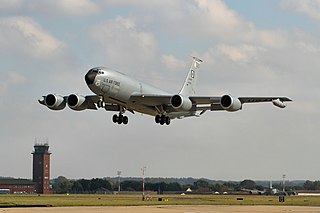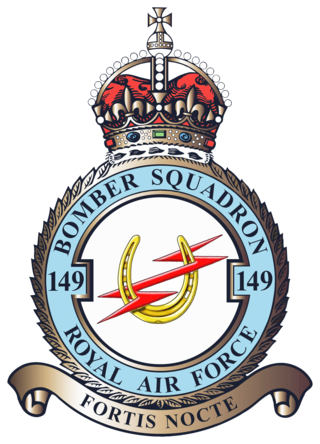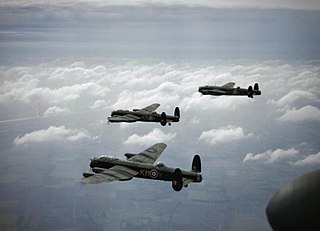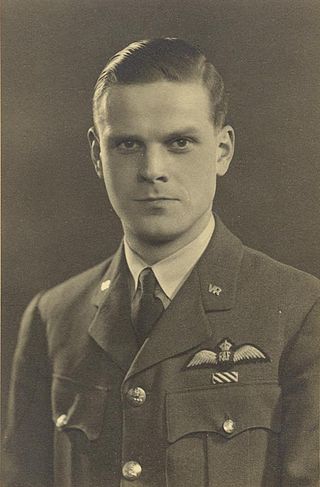
The Vickers Wellington is a British twin-engined, long-range medium bomber. It was designed during the mid-1930s at Brooklands in Weybridge, Surrey. Led by Vickers-Armstrongs' chief designer Rex Pierson; a key feature of the aircraft is its geodetic airframe fuselage structure, which was principally designed by Barnes Wallis. Development had been started in response to Air Ministry Specification B.9/32, issued in the middle of 1932, for a bomber for the Royal Air Force.

Royal Air Force Mildenhall, or more simply RAF Mildenhall, is a Royal Air Force station located near Mildenhall in Suffolk, England. Despite its status as a Royal Air Force station, it primarily supports United States Air Force (USAF) operations, and is currently the home of the 100th Air Refueling Wing.

Number 12 Squadron, also known as No. 12 (Bomber) Squadron and occasionally as No. XII Squadron, is a flying squadron of the Royal Air Force (RAF). The squadron reformed in July 2018 as a joint RAF/Qatar Emiri Air Force squadron. It is currently based at RAF Coningsby, Lincolnshire, and operates the Eurofighter Typhoon FGR4, while temporarily integrating Qatari air and ground crews in order to provide training and support as part of the Qatari purchase of 24 Typhoons from the UK.

James Allen Ward, VC was a New Zealand aviator and a recipient of the Victoria Cross (VC), the highest award for gallantry "in the face of the enemy" that could be awarded at the time to personnel of the British and Commonwealth forces.

No. 149 Squadron RAF was a Royal Air Force Squadron between 1918 and 1956. Formed 1918 in the Royal Flying Corps as a night-bomber unit, it remained in that role for the rest of its existence which spanned three periods between 1918 and 1956.
No. 90 Squadron RAF is a squadron of the Royal Air Force.

Group Captain Percy Charles "Pick" Pickard, was an officer in the Royal Air Force during the Second World War. He served as a pilot and commander, and was the first officer of the RAF to be awarded the DSO three times during the war. He flew over a hundred sorties and distinguished himself in a variety of operations requiring coolness under fire.

Royal Air Force Polebrook or more simply RAF Polebrook is a former Royal Air Force station located 3.5 miles (5.6 km) east-south-east of Oundle, at Polebrook, Northamptonshire, England. The airfield was built on Rothschild estate land starting in August 1940.

No. 420 "City of London" Squadron RCAF was a squadron of the Royal Canadian Air Force (RCAF) which existed from late December 1941 forwards. The Squadron's nickname was "Snowy Owl". Their motto was Pugnamus Finitum, Latin for We Fight To The Finish. No. 420 Squadron is no longer active.

No. 304 Polish Bomber Squadron was a Polish World War II bomber unit. It fought alongside the Royal Air Force under their operational Command and operated from airfields in the United Kingdom, serving from April 1941 as a bomber unit in RAF Bomber Command, from May 1942 as an anti-submarine unit in RAF Coastal Command and from June 1945 as a transport unit in RAF Transport Command.

No. 214 Squadron is a former unit of the Royal Air Force.

Number 44 (Rhodesia) Squadron was an aviation unit of the Royal Air Force. It was active between 1917 and 1982. For most of its history it served as a heavy bomber squadron.

No. 466 Squadron RAAF was a Royal Australian Air Force (RAAF) bomber squadron during World War II. Formed in the United Kingdom in late 1942, the squadron undertook combat operations in Europe until the end of the war, flying heavy bomber aircraft. Following the conclusion of hostilities with Germany, the squadron began retraining to undertake operations in the Pacific against the Japanese, but the war came to an end before it left the UK. In late 1945, the squadron was disbanded.
Squadron Leader Henry Melvin "Dinghy" Young, was a bomber pilot in the Royal Air Force Volunteer Reserve during the Second World War.

The Battle of the Heligoland Bight was the first "named" air battle of the Second World War, which began the longest air campaign of the war on 3 September 1939, the Defence of the Reich. After the declaration of war, RAF Bomber Command began operations against Nazi Germany but limited their attacks to those targets that were purely military and had little risk of civilian casualties. This largely limited their efforts to attacks on the Kriegsmarine warships in German ports to prevent their use in the Battle of the Atlantic.
Werner Baake was a night fighter pilot fighter ace and recipient of the Knight's Cross of the Iron Cross who served in the Nazi German Luftwaffe during World War II. The Knight's Cross of the Iron Cross was awarded to recognize extreme battlefield bravery or successful military leadership. Baake claimed 41 nocturnal aerial victories in 195 combat missions. He was the 36th most successful night fighter ace of World War II, and of aerial warfare. Baake's total surpassed that of all Allied night fighter pilots; Branse Burbridge being the highest.

Wing Commander Peter Stanley James, was a pilot in the Royal Air Force Volunteer Reserve during the Second World War, flying in RAF Bomber Command with No. 35 Squadron, No. 78 Squadron and No. 148 Squadron.
Wing Commander David William Holford was a Royal Air Force officer who was the youngest bomber squadron commanding officer in RAF history. He was killed after crashing his Lancaster in thick fog near Kelstern following an operation to bomb Berlin.

The aircrews of RAF Bomber Command during World War II operated a fleet of bomber aircraft carried strategic bombing operations from September 1939 to May 1945, on behalf of the Allied powers. The crews were men from the United Kingdom, other Commonwealth countries, and occupied Europe, especially Poland, France, Czechoslovakia and Norway, as well as other foreign volunteers. While the majority of Bomber Command personnel were members of the RAF, many belonged to other air forces – especially the Royal Canadian Air Force (RCAF), Royal Australian Air Force (RAAF) and Royal New Zealand Air Force (RNZAF). Under Article XV of the 1939 Air Training Agreement, squadrons belonging officially to the RCAF, RAAF, and RNZAF were formed, equipped and financed by the RAF, for service in Europe. While it was intended that RCAF, RAAF, and RNZAF personnel would serve only with their respective "Article XV squadrons", in practice many were posted to units of the RAF or other air forces. Likewise many RAF personnel served in Article XV squadrons.

Everett Ernest Blakely was a career officer of the United States Air Force. He was a highly decorated B-17 pilot with the “Bloody Hundredth” Bombardment Group of the 8th Air Force in Europe during World War II. He received eleven medals for his service including the Silver Star for “gallantry in action”, the Distinguished Flying Cross for “heroism or extraordinary achievement during aerial flight” and the Air Medal with 4 oak leaf clusters. Blakely and the crew of his plane “Just A Snappin” long held the record for the most enemy aircraft shot down on a single mission. The crew of Just A Snappin was credited with 9 enemy aircraft shot down. He also received his Pilot Wings with 3 stars from the Colombian Air Force.

















